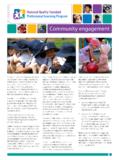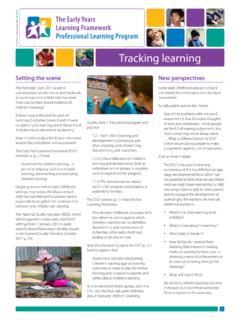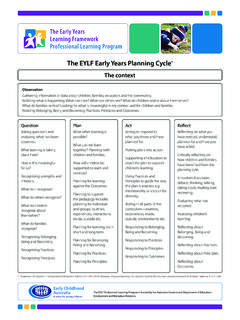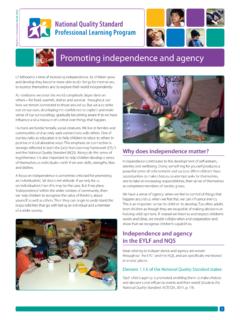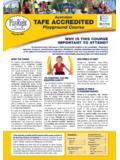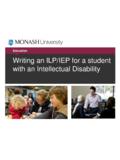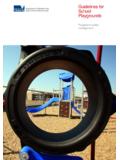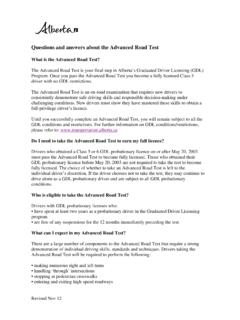Transcription of Being intentional - Early Childhood Australia
1 1 NQS PLP e-Newsletter 2014 Setting the sceneIntentional teaching is one of the eight pedagogical practices identified in the Early Years Learning Framework (EYLF) (DEEWR, 2009) as essential to promote children s seven Quality Areas of the National Quality Standard (NQS) (ACECQA, 2011) together underpin a quality learning experience for young following Quality Areas, standards and elements of the NQS strongly relate to educators Being intentional : : Educators and coordinators are focused, active and reflective in designing and delivering the program for each child. : Educators respond to children s ideas and play and use intentional teaching to scaffold and extend children s learning. : The environment is inclusive, promotes competence, independent exploration and learning through play. : Staffing arrangements enhance children s learning and development and ensure their safety and wellbeing. : Every child is able to engage with educators in meaningful, open interactions that support the acquisition of skills for life and learning.
2 : Continuity of learning and transitions for each child are supported by sharing relevant information (with families) and clarifying responsibilities. : Provision is made to ensure a suitably qualified and experienced educator or coordinator leads the development of the curriculum and ensures the establishment of clear goals and expectations for teaching and intentional2 Being clear about what we mean by the words we useIn Early Childhood education and care (ECEC), we tend initially to be wary about a term such as intentional teaching . We may associate intentions with hard-edged, measurable targets that involve comparing children or expecting them all to reach the same milestones at the same time. In Early Childhood , we know that young children s learning is distinctively rapid, uneven and individual and that normative comparisons or expectations are , in reality, we do and should have goals, plans and specific learning objectives for the children we work with.
3 We have broad goals for the whole group, such as: I will support this group of children to learn to interact in relation to others with care, empathy and respect (Outcome 1, Key Component 4); or to become socially responsible and show respect for the environment (Outcome 2, Key Component 4).And, we have more specific objectives for particular children such as to develop their sense of belonging and resilience (reflecting Outcome 1) because we recognise that the child finds separating from their family and feeling at home in the learning setting difficult. Or, in a more academic area, we may note that some children are beginning to use symbols shapes, letters and numbers in their art work. We therefore plan to show them how those symbols are used in numeracy and literacy contexts and provide materials and opportunities for them to represent their ideas in ways that make sense for are Being intentional ; but we are also Being responsive.
4 As Sandra Cheeseman, in e-Newsletter , 2012 explained:The three practices of responsiveness to children, learning through play and intentional teaching all meld together when watching a highly effective educator you can see them move seamlessly from creating a play situation, choosing different ways to be involved with children and their ideas, and drawing out the potential learning in the situation through their challenges and provocations which develop the play thoughtful about children s needsThe EYLF defines intentional teaching as: deliberate, purposeful and thoughtful (p. 15).Sarah is very aware that Bobbie has problems processing information and with emotional self-regulation. She watches him trying to construct a castle with boxes after he has been to the jumping castle at the weekend. She talks with him about which boxes to choose, scaffolding his planning and thinking ahead. He begins to cut long, narrow windows but Sarah notices that Bobbie s frustration is building because he is impatient to get the job done and has limited fine motor skills.
5 She assists him to cut two windows; they talk together and decide that painting the windows on might be easier and look pretty good. Sarah s conversation keeps Bobbie on track so that he can achieve his goals and she is modelling planning and problem solving so that he learns how to approach future tasks in a constructive way. Sarah documents the amount of dedicated time Bobbie spent on tasks and notes which strategies helped him to persist and the EYLF (p. 15) explains:Educators who engage in intentional teaching .. use strategies such as modelling and demonstrating, open questioning, speculating, explaining, engaging in shared thinking and problem solving to extend children s thinking and teaching doesn t only happen with older children. When an educator plays peek-a-boo with a baby and creates a now you see it, now you don t game with a toy, they are intentionally building the baby s capacity to interact socially and developing concepts about how an object is separate from one s own body and objects exist even when we can t see them.
6 When a toddler learns to throw a ball up high and tries to get it onto the shade cloth, the educator delights in their efforts and intentionally talks about high and low, up and down, fast and slow; they are building the child s language and understanding about how objects can move through space and how humans can affect what objects course, Being intentional does not always mean the educator directly intervenes. If a child is absorbed in their own exploration playing with finger paint, watching a sunset, holding their hand under moving water for example making the thoughtful, deliberate decision to stand back is a sensitive intentional act on the part of the teaching also happens around the transitions children make. When a child appears unhappy about moving to a new educator, or a new room, conversations with the family can help all of the adults to support the child. They may agree that the child needs to make the transition gradually, getting to know the new physical and social space over time; they may plan for a particular staff member to greet the child and family each day until the child is settled and situation is different and calls for different ways of Being intentional .
7 Chris has a group of children who have English as an additional language. He makes learning language fun, saying rhymes and singing songs, playing guitar and CDs and making up action games about colours, positional language and opposites. Jack and Jill went UP the hill ; the monkey hangs in the tree, the fish swims in the sea .. ; big dogs, small dogs, short dogs, long dogs, black dogs, white dogs ; the slippery eel slides down the slimy bank into the clear, blue water . Being flexibleThe EYLF suggests that: Educators move flexibly in and out of different roles and draw on different strategies as the context changes .Mandy has set up a very creative preschool space. She encourages the children to take responsibility for leaving each area (paints, collage, boxes, clay etc.) in a tidy condition for others. She sits with Ben who is constructing a pirate s hat, asking questions and encouraging him to measure the hat band to fit his head.
8 Another group is planning a puppet play. Mandy talks with them about how an audience behaves, how a play is introduced and in what sequence the story might be told. The children decide to have a practice with some Being puppeteers and others role playing an is moving in and out of different roles with Ben and the puppeteers. With Ben, she acts as a guide and mentor sitting quietly alongside him. With the puppeteers, she has a more active role in (2011) describes educators roles in children s play as: Parallel player doing similar tasks alongside Script writer helping to tell the story Stage manager providing space, props, prompts Co-constructor asking questions, making suggestions Participator with children s agreement, taking a direct role Modelling showing how to enter and exit play; how to negotiate Challenger Asking: Is this fair? Will they understand what we mean?Sometimes, the best laid plans can go awry!Norah is a young educator who is enormously enthusiastic and excited about the things young children can learn.
9 She sets up the water tray with bottles of different sizes, pouring spouts and coloured water. She has planned for the children to learn about volume (how much water is in the container) and capacity (how much water a container can hold). A big group of children come to play at the water tray. They splash joyfully, run off and play elsewhere and return. Norah s intentions are clearly not going to be realised! However, some of the children are beginning to use comparative language that one s really full, that one s empty . So, Norah sets up the water tray experiment in a different part of the playground and supports the small group in their investigation of ideas relating to measurement in NQS Professional Learning Program is funded by the Australian Government Department of to you byBiographyJenni Connor undertakes research and writing into learning, curriculum and educational issues generally.
10 She was author of the 2011 e-Newsletters and responsible for coordinating the 2012 and 2013 series. Jenni has a number of publications with ECA, including Your Child s First Year at School, 2012 and Foundations for Learning, an ECA/ACARA paper, Children s Education and Care Quality Authority (ACECQA). (2011). Guide to the National Quality Standard. Sydney: ACECQA. Department of Education, Employment and Workplace Relations (DEEWR). (2009). Belonging, Being and Becoming: The Early Years Learning Framework for Australia . Canberra: , S. (2012). Responding to children s play. NQS PLP e-Newsletter , L. (2010). ECA Conference Master Class on has provided challenging learning experiences that promote learning and she realises that the children are at different stages in their interest in and ability to understand particular concepts. She therefore flexibly amends her own intentions to match children s interests and needs and provides resources for them to follow up their own intentions and goals.

